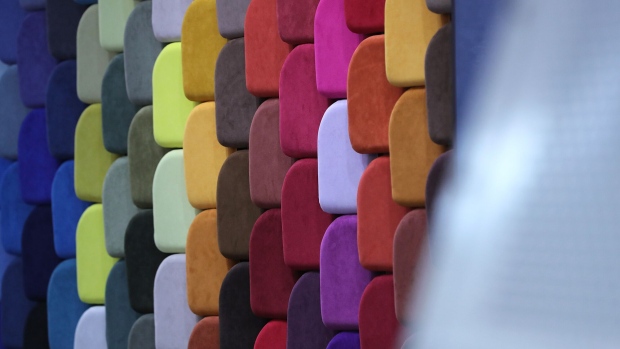Mar 20, 2023
Alcantara Is for More Than Just Your Supercar
, Bloomberg News

(Bloomberg) -- If you’re into cars, you’ve heard about Alcantara.
The suede-like fabric covers the steering wheels of Lamborghini Huracáns and Porsche 911s, as well as the seats of BMW i8s and Bugatti Chirons. The new Ferrari Purosangue SUV offers a special interior trim option that includes Alcantara made from recycled materials.
But the company that makes it, founded in 1972, comes from a background far more varied than just four wheels. A book out April 25, Alcantara, The Material of Art (Skira, $52), explores the material’s colorful history.
Created by Toray Industries Inc. scientist Miyoshi Okamoto in the late 1960s, Alcantara is composed of 68% polyester and 32% polyurethane. It takes its name for the Arabic word for bridge, al-quantarah. Okamoto had described his creation as “islands in the sea” when viewed under a high-powered microscope, so naming the tiny clusters after a bridge seemed a fitting way to unite them.
At the time, the Japanese scientist thought his material, which resembled chamois leather, could be used for shoe uppers, because it was soft to the touch while remaining flexible and—best of all—waterproof. He filed the first patent for it in 1970, and in 1972 Alcantara SpA began as a joint venture between Italian chemical company Eni Group and Toray. (Toray invented another mass commercial hit, rayon, and today is the world’s largest producer of carbon fiber, supplying it for big items such as the exterior components of Boeing 787 airplanes.) Toray held 49% of the shares, while Eni held the majority 51%.
By 1978, Okamoto’s high-tech fabric was appearing in car seats, and the company’s manufacturing plant in Nera Montoro, Italy, had earned a reputation as a tailor of cars. (Its corporate offices are in Milan.)
The Alcantara’s beauty as an industrial material is that it’s durable and washable, and, unlike leather, breathable. That made it the go-to option for sports- and luxury-car brands; whereas leather-covered steering wheels can get slippery when hands get sweaty, as they invariably do, Alcantara’s velvety outer makes for a tight, slip-free grip on the wheel.
The material absorbs ink very well, too, making it dyeable to virtually any hue. Fiat was the first major auto-related customer. Collaborations with Audi and Lancia followed, then Alfa Romeo, Subaru, Maserati and McLaren.
Applications for its use soon reached far beyond cars. In the 1980s and 1990s, apparel designers and interior decorators used Alcantara to denote how refined and exclusive their collections were. It helped that the material was especially resistant to twisting and tearing, which made it great for jackets, hats and gloves.
In 1995, Toray bought out its Italian partners and remains a 70% shareholder in Alcantara; Mitsui & Co. Ltd. owns the rest. (Fashion still loves Alcantara—in 2018, Dutch designer Iris van Herpen created an exhibit at the Palazzo Reale centered around a sculptural dress of slender strips of white Alcantara.)
Then, in 2004, a new managing director called Andrea Boragno said he wanted to involve the company in the art world. After all, it was easy to print and paint on Alcantara; it held up to those mediums as a canvas, too. Being lightweight, it lends itself to a multitude of forms: 10,000 meters (32,808 feet) of fibers weigh just 1 gram (0.04 oz); when woven into its leather approximate, say for upholstery use, it’s about 50% the weight.
Early projects included collaborations with the MAXXI Museum in the Flaminio district of Rome. Set in a building designed by Zaha Hadid, the museum held exhibits underscoring the properties of technology and how they influence design. The artist Massimilian Adami superimposed layers of Alcantara into a stalagmite-type figure; Francois Azambourg created a panel wall of Alcantara folded like origami.
Later artistic works supported by the company included tapestry-like wall-hangings in the Palazzo Reale in Milan and calligraphy done on Alcantara as a way to bridge—there’s that word again—ancient traditions with modern invention.
Today, Alcantara counts hundreds of patents associated with its novel microfiber fabric. And Okamoto is esteemed for his invention: Toray named a research lab after him. In 2001, he received the Leonardo Prize for his contribution to world-renowned products made in Italy.
Alcantara, The Material of Art is available for preorder now. Deliveries begin in April.
©2023 Bloomberg L.P.


